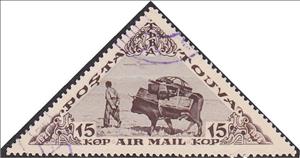Stamp: Yak used for transport (Tannu Tuva 1936)
Yak used for transport (Tannu Tuva 1936)
01 January (Tannu Tuva ) within release 15th Anniversary of Independence Airmail goes into circulation Stamp Yak used for transport face value 15 Tuvan kepejek
| Stamp Yak used for transport in catalogues | |
|---|---|
| Stamp Number: | Sn:TX C12 |
| Michel: | Mi:TX 100 |
Stamp is horizontal format.
Also in the issue 15th Anniversary of Independence Airmail:
- Stamp - Yak used for transport face value 5;
- Stamp - Horse-drawn reaping machine face value 10;
- Stamp - Yak used for transport face value 15;
- Stamp - Airship and rider on horseback face value 25;
- Stamp - Women's day face value 50;
- Stamp - Airship and rider on horseback face value 75;
- Stamp - Airplane over dragon face value 1;
- Stamp - Airplane over dragon face value 2;
- Stamp - Airplane over dragon face value 3;
Stamp Yak used for transport it reflects the thematic directions:
Animals are multicellular, eukaryotic organisms of the kingdom Animalia (also called Metazoa). All animals are motile, meaning they can move spontaneously and independently, at some point in their lives. Their body plan eventually becomes fixed as they develop, although some undergo a process of metamorphosis later on in their lives. All animals are heterotrophs: they must ingest other organisms or their products for sustenance.
The Kionga Triangle (German: Kionga-Dreieck, Portuguese: Triângulo de Quionga) was a small region of German East Africa situated at the mouth of the Ruvuma River. The Ruvuma served as the border between the German colony and Portuguese Mozambique, and the Kionga Triangle was the only section of German East Africa south of the river. Its principal settlement was Kionga (now Quionga ) which had a population of 4,000 in 1910. It became a German possession in 1894 but came under Portuguese control in April 1916 during World War I. The post-war Treaty of Versailles reaffirmed that the river was the border between Tanganyika, then under British control, and Portuguese Mozambique. The triangle was the only territory that the treaty awarded to Portugal.

